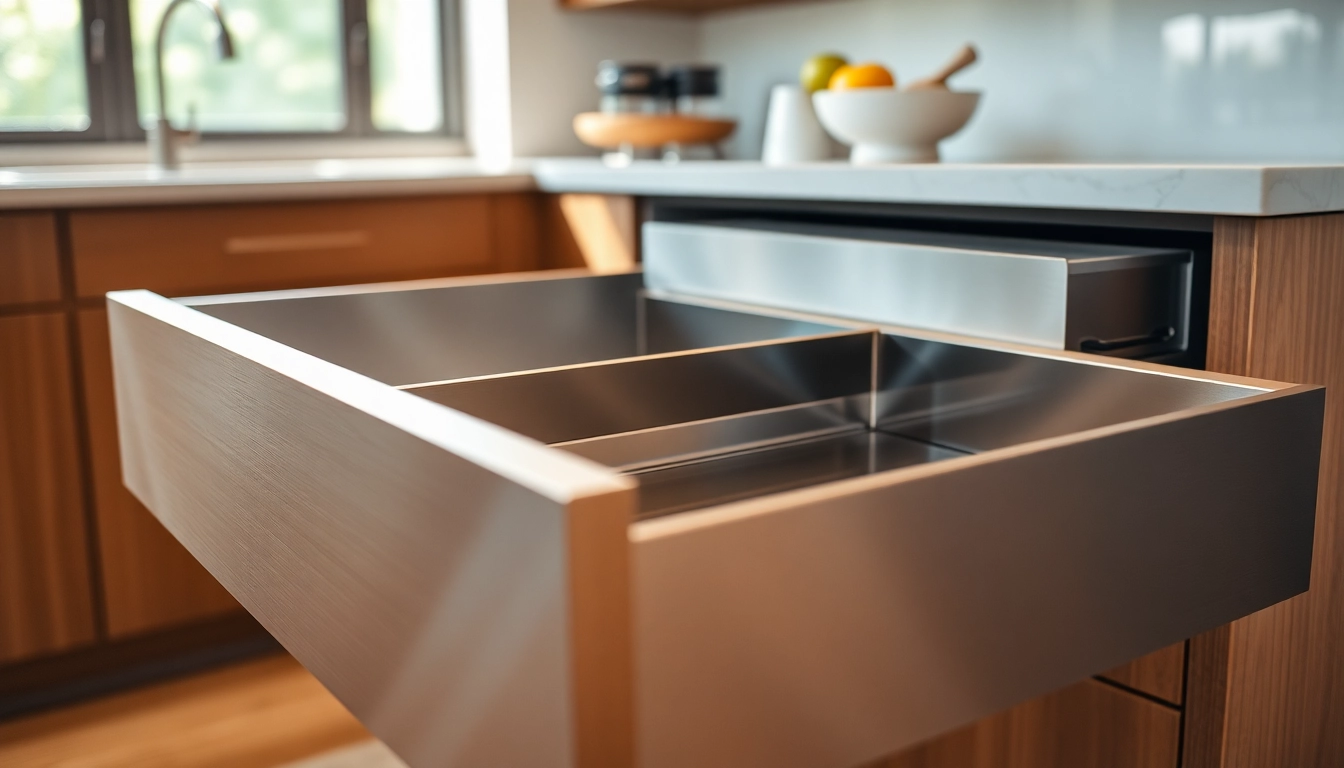1. Understanding Metal Drawer Systems
1.1 What is a Metal Drawer System?
At its core, a Metal Drawer System consists of a framework engineered to facilitate the smooth and secure storage of various items within residential or commercial settings. These systems leverage metal’s advantageous properties—strength, durability, and aesthetic appeal—to form reliable and functional drawer units. They are prevalent in kitchen cabinets, office storage units, workshop benches, and commercial fixtures due to their robustness and reliability.
1.2 Types and Materials Used
Metal drawer systems can be constructed using a variety of materials, with steel and aluminum being the most common. Steel drawers often come with a powder-coated finish for enhanced corrosion resistance, while aluminum is favored for its lightweight properties. Other materials, such as stainless steel, are utilized in professional environments such as kitchens and workshops where durability and resistance to corrosion are paramount. Additionally, the design of metal drawer systems can vary, from basic open shelves to complex, seamlessly integrated drawer boxes that utilize various sliding mechanisms.
1.3 Advantages of Choosing Metal Drawers
The choice of metal drawers over other materials brings numerous advantages. Firstly, they offer superior load capacity, often accommodating heavier items without the risk of warping or breaking. Metal drawers also provide enhanced security; the robust design makes them more difficult to damage or break into. Furthermore, they are easier to maintain and clean, with many designs featuring smooth surfaces that resist dust and grime accumulation. Lastly, metal features a modern aesthetic that can enhance the overall design of a room.
2. Key Features of Metal Drawer Systems
2.1 Load Capacity and Durability
Load capacity is a defining feature of any metal drawer system. Depending on the design and materials used, metal drawers can typically support anywhere from 50 lbs to over 500 lbs. This makes them ideal for both light domestic usage and heavy-duty commercial applications. Durability is also a key feature, with many systems designed to endure years of frequent use without significant wear and tear. The incorporation of ball-bearing slides in many designs further enhances the smooth operation and longevity of the drawer system.
2.2 Design Options and Customization
Modern metal drawer systems offer extensive design options. From colors to finishes, consumers can select designs that best fit their aesthetic needs. Customization features are prevalent in many systems, allowing builders and designers to select specific dimensions, drawer depths, and compartment configurations to meet particular functional requirements. Such flexibility makes these systems suitable for a variety of environments, from minimalistic homes to robust industrial settings.
2.3 Installation Methods and Ease of Use
Installation methods for metal drawer systems have become increasingly user-friendly. Most systems follow straightforward guidelines and can be installed using basic tools. Some products even feature pre-drilled holes, which expedite the process. In terms of usability, many metal drawers come equipped with features like soft-close mechanisms and self-closing technologies that enhance user experience, making operation quiet and smooth.
3. Comparing Metal Drawer Systems to Other Materials
3.1 Metal vs. Wood: Pros and Cons
When comparing metal and wood drawer systems, it’s important to analyze their strengths and weaknesses. Metal generally provides superior load-bearing capability, resistance to moisture, and a modern aesthetic. On the other hand, wood offers warmth and a classic look, making it an appealing choice for traditional designs. However, wood may be prone to warping, scratches, or damage from water, while metal can dent or scratch under heavy impact. As such, the choice between these materials often hinges on usage context and personal design preferences.
3.2 Performance in Various Environments
Metal drawer systems outperform their wooden counterparts in challenging environments. In damp areas such as kitchens and bathrooms, metal’s resistance to moisture makes it a go-to choice. In industrial settings, metal drawer systems are designed to withstand harsh conditions, providing unmatched durability and functionality. Conversely, wooden systems may struggle in these settings, leading to the gradual degradation of structural integrity.
3.3 Cost-Effectiveness of Metal Systems
While metal drawer systems can have a higher upfront cost compared to wood, they often provide better long-term value. Metal’s durability means that these systems can last significantly longer, often without needing replacement or repair. Additionally, their low maintenance requirements mean fewer costs associated with upkeep, making them a cost-effective solution over time.
4. Ideal Applications for Metal Drawer Systems
4.1 Home Use: Kitchens and Offices
In residential settings, metal drawer systems serve numerous purposes, particularly in kitchens and home offices. Kitchen cabinets equipped with metal drawers, for example, can effortlessly hold heavy pots, pans, and food items, providing easy access and organization. Similarly, in home offices, metal drawers are valued for their ability to securely store documents and stationery while maintaining a sleek, professional appearance.
4.2 Commercial Use: Retail and Industry
Within commercial environments, metal drawer systems are central fixtures in retail settings and industrial workplaces. Retail operations utilize these systems for stock storage and merchandising displays, benefitting from their sturdy design. In manufacturing and industrial facilities, metal drawers offer reliable storage for tools and equipment, withstanding rigorous use and heavy loads without compromising functionality.
4.3 Specialty Applications: Workshops and Garages
Workshops and garages require storage solutions that can withstand heavy use; metal drawer systems fit the bill. They are often used to store heavy tools, fasteners, and DIY supplies due to their robust construction. The capacity of these drawers to manage weight and remain organized under demanding conditions makes them the ideal choice for hobbyists and professionals alike.
5. Maintenance and Care for Metal Drawer Systems
5.1 Routine Checks and Upkeep
To ensure the longevity and smooth operation of metal drawer systems, regular maintenance is essential. Routine checks should include verifying the integrity of drawer slides, ensuring that moving parts are free from debris, and inspecting for signs of wear, such as rust or corrosion. Addressing these issues promptly will prevent minor complications from developing into major problems.
5.2 Troubleshooting Common Issues
Common challenges faced with metal drawer systems often relate to misalignment or sticking. If a drawer is not sliding smoothly, the first step is to check for obstructions in the slide path. If everything appears clear, you may wish to adjust the alignment of the slides to ensure a proper fit. In situations where drawers stick, applying a lubricant specifically designed for metal can alleviate friction.
5.3 Enhancing Longevity Through Care
To enhance the longevity of metal drawer systems, proper care is critical. Regular cleaning of surfaces will prevent the buildup of grime that can damage finishes, and promptly addressing scratches or dents will keep the unit looking new. For systems exposed to moisture, a protective coat or sealant can further guard against rust and deterioration.



